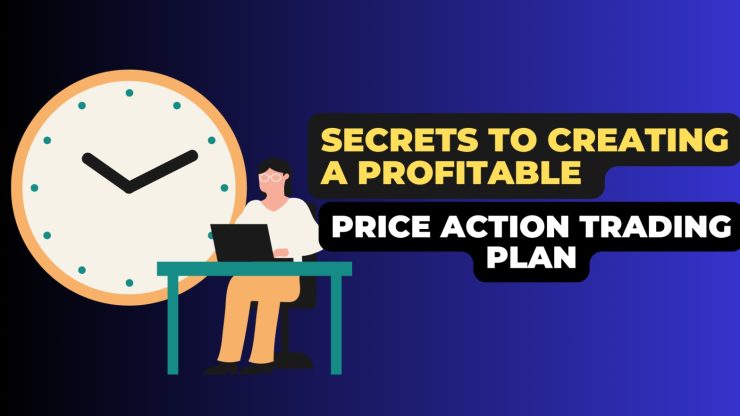Many traders think trading is all a bed of roses and it does not require any plan before engaging themselves in it.
As with every phase of life, if you fail to plan, then you’re ultimately planning to fail.
Hence, every trader needs a profitable trading plan that would help them navigate their path through the uncertain journey of trading.
To help you with this, I have written this article, to reveal to you the secret ingredients and recipes that a profitable price action trading plan entails.
Key Takeaways
- Having a trading plan is like having a roadmap for your journey in trading—it guides your decisions just like a hiker relies on a map in the mountains.
- Your trading plan needs to cover key areas like skill assessment, managing risks, knowing when to enter and exit trades, and keeping track of your trades.
- Knowing when to exit a trade is just as important as knowing when to get in—it can make a big difference in your profits.
- When creating your trading plan, think about why you’re trading, set realistic goals, understand your risk tolerance, and choose the market that suits you best.
- Your trading plan helps you make smart, objective decisions instead of acting on emotions.
What is a Trading Plan?
To start with, a Trading plan is a written document that contains the well-defined steps you take when trading.
This is like a road map that guides every of your trading decisions.
This is just like a hiker who relies on a road map that would help him navigate through the mountains and thick forests.
Secret Ingredients You Need When Creating A Profitable Trading Plan
Skill Audit:
This aspect of your trading plan requires you to ask yourself these questions-
Are you really competent enough to beat the odds that lie ahead of you in the market?
Have you been consistently profitable while strictly adhering to your trading plan using demo or Paper Trading?
How much confidence do you have in your trading system?
How successful has your trading plan been when backtesting?
When you honestly give yourself feedback on this, and you see you’ve ticked all the boxes completely, then why not? Go ahead.
But if you falter in any of these, then work on your weakness.
Risk Appetite and Management:
As with every business, the risk is inherent.
Your Risk appetite is how much risk you can bear on every trade you place should the market structure go against you.
This largely depends on your personal self and your trading style.
As a general reliable guideline, a good risk should be between 1-2% and a maximum of 3% of your total equity.
For example, if you have a $1,000 trading account, then your risk should not be more than $20 ( that is 2% of your total equity) on each trade over a period of time determined by your trading approach.
The question now is…
Would you be able to afford to lose $20 on a $1,000 account without losing your mind?
Let’s take for example
You had a 5 trade-losing streak, this would amount to just a total of $100 of your $1,000 ( i.e. $20*5 =$100).
This means you still have $900 reserved.
If also, you have a 1:2 risk to reward on every trade you place, this means that after 5 winning trades, you have 20*2*5= $200 profit on equity.
This means $1,200 bagged!!!
Can you see the power of compounding and following strict management rules?
As a trader, you should look to have at least 1:2 RR on every trade before taking positions.
A very good benefit of risk management is that it helps save you from emotional trading (which many traders are guilty of).
It keeps you in a normal mental state and makes you less impulsive to the reactions of the market especially when the market is moving against you.
Hence, you would want to make this a primary objective before entering any trade at all.
Fix Exit Rule(s):
One popular myth is that “ Your entry strategy makes you money”.
Well, as an experienced trader, I can tell you for free that knowing when to get out of a trade makes you even more money than your entry.
Your trading plan needs to be contain when you exit the market.
The exit metric of your trading plan needs to be determined by you as a trader.
Some exit rules span from support and resistance levels to Fibonacci retracement to daily highs and lows among others.
It helps you curb unnecessary greediness when the market is going in your favor.
For a newbie, sticking to one conservative exit strategy helps you master yourself and in turn, your trading system.
As you grow in the world of trading and gain more experience, you would be able to master the best exit system that suits your style of trading.
Remember, your exit is highly subjective as a trader.
Set Entry Rules:
So the question now is, since you have a well-defined exit, then how would you enter a trade?
Just as the exit rules are mainly by discretion and trading style, so also is your entry rule.
How do you trade? Are you a pullback, trend, or break-out trader?
There are just too many rules that come into play when determining entry rules and you as a trader need to know these secrets when building a trading plan.
Here is an example of a typical trading entry – “If the price gets to the support zone then I buy X lot of the currency pair, then if it gets to a resistance zone, I either sell all or Y amount of my lot size”
If you don’t have expressly stated rules on entry and exits such as this, then you would fall into the trap of jumping into one trade or the other which could lead to disaster for your trading account.
Remember, just like your exit rules, stick to one entry rule.
Then as you gain more experience you would be able to add to your rules or make some amends.
Trade Management:
This is a topic that is not often talked about which is why it is among the secret recipes of a trading plan.
Trade management is quite different from money or risk management. So do not mix them up.
The question that this topic answers is “What do you do when you’re in a trade?” “When do you move your stop loss to breakeven or above breakeven?”
Your trading plan needs to clearly state how you move your stops.
It can include stuff like- Do you want to trail your stops, scale in, or scale out?
Sometimes, you might just want to keep a position static till it hits either your profit target or your stop loss leaving the markets to do their thing.
These traders are often called, “ The set and forget traders”
The range of options provided here is very important under this topic and in your trading plan.
So, make very good use of the information you have gotten here.
Keep Detailed Track Records:
Track records involve the trade you place when you place them and your reasons for placing those trades.
Whether you won or lost the trade, document it! This is one of my secret recipes and also, and it is the secret ingredient of many professional and profitable traders.
This reveals the strength and weaknesses of your trading system to you and also, shows you where you need to make amends.
In line with this topic, always analyze how well you have done over a period of time.
It could be weekly (for day traders), monthly or quarterly (for swing traders), and on and on like so.
Keeping these records also helps you when sourcing potential investors because you have a well-packaged record of your trades which every investor wants to see.
So, there you go. the secret steps you need to take when creating a profitable trading plan.
Using these steps given to you, how then do you create your plan?
How To Create A Profitable Trading Plan
Here are the questions you need to answer in your trading plan just before creating a plan-
What is your reason for trading?
Answering this question helps you to figure out why you want to be a trader and your driving force for trading.
It helps you stay committed and motivated when trading.
Through this, you can also figure out how much time you’re willing to give into trading.
So write it down.
What are your targets?
You need to know your goals and objectives for trading and what you expect from trading after a defined period of time.
I would advise you to have an achievable and reasonable short-term goal and more importantly a long-term goal of what you expect from trading no matter what type of trader you are.
These targets are what keep you motivated while trading.
Add them to your plan.
How much risk can you bear?
From your style of trading and emotional standpoint, what is your risk tolerance? Answer this question and write it down as part of the plan.
This also leads you to set a Risk to Reward goal which means, if you can’t see a potential risk to reward, say 1:3 RR, then you’re not entering into the trade come what may.
What is your Market of Choice?
In the financial world, there are different types of markets available to traders.
These are the forex, stocks, bond, and futures market among others.
But each with its own unique characteristic which makes it different from others.
This means, after long and well-detailed research, a forex market trading plan would be quite different from a stock market trading plan and your market preference would come after you have done a lot of research and seen the one that suits your trading system.
Make research and write down your takeaways.
So there you have it.
The secret steps and questions you need to ask yourself just before creating and when creating a trading plan.
To cap it all…
Your trading plan is what guides you into making more systematic and objective trading decisions rather than from an emotional point of view.
All secrets and questions contained in this article should be present in your trading plan as you embark on this journey.
Consistent and everyday backtesting and forward testing is not a guarantee to yield a 100% win-win situation for you when trading live funds but it is a very strong and necessary foundation in your trading career which helps you stay in the game.
Trading is largely subjective and no two traders can have the exact type of plan, so make yourself reflect through your trading.
Share your thoughts with me on how your trading plan has helped you in your career.
Learn More: Price action Patterns That works In Trading


